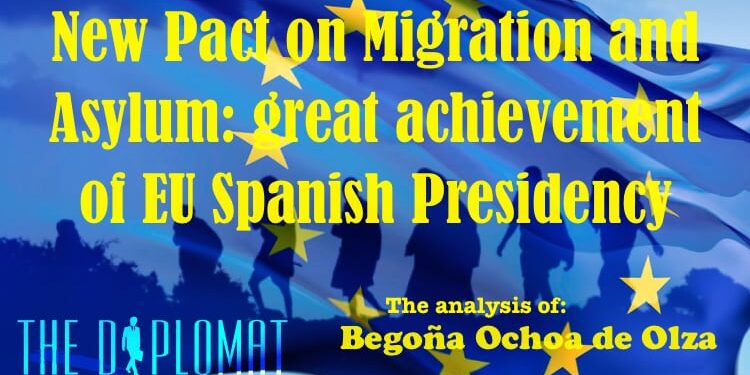SUMMARY
The European Union’s new Pact on Migration and Asylum has been one of the great achievements of the Spanish Presidency of the EU, especially because until now European migration rules were based solely on the principle of responsibility, according to which the country of first entry of migrants was responsible for examining their asylum applications. The reform also adds the principle of solidarity, whereby other member states will be obliged to assist countries of first entry in managing migration.
Begoña Ochoa de Olza
Queen Mab, in her one-pearl chariot, pulled by four beetles, walking on a ray of sunshine, slipped through a garret window. This story from Rubén Darío’s Azul begins with an allegory that could well be the European Union, inexorably moving in an unknown direction. In this inexorable advance, the question of migration is one of the burning issues that is conditioning the current European debate.
In this context, the adoption of the New Pact on Migration and Asylum is undoubtedly one of the major achievements of the Spanish Presidency of the Council of the European Union. This has been stated by the highest authorities at European and national level. And this can be seen from a technical assessment of the Pact. Unfortunately, in recent months, this Pact has also been the subject of numerous criticisms, even being described as a “lost opportunity”. For this reason, and given the technical nature of the negotiations, we will try to explain in simple terms what the agreement consisted of, and we will make a personal assessment of it.
It seems that in the 21st century we live in the mirage of a polarised and Manichean reality. However, we should not allow ourselves to be carried away by what would appear to be distorted shadows according to Plato’s famous myth of the cave. In particularly complex disciplines, such as international relations or geopolitics, it is widely known that, in order to make an accurate assessment, it is necessary to turn to specialised think tanks capable of providing a well-founded analysis, beyond the simplifications that the media usually make. I would therefore like to stress the complexity of the migration issue, as well as the need to take into account different nuances and underlying issues. As a starting point, therefore, it seems more prudent to approach such a sensitive issue from a nuanced and moderate perspective.
A number of points should be made:
- The double merit of the Spanish Presidency in achieving an agreement that was frustrated in 2016, due to a lack of sufficient consensus.
- The complexity of the European negotiating process, precisely for the sake of bringing together a plurality of interests at stake. In brief, it could be summarised in the following phases: the process begins with a proposal from the Commission and subsequently consists of three readings, with the first reading taking place in an informal inter-institutional format, through the so-called “trialogues” (with representatives of the Council, the European Parliament and the Commission) in order to reach an agreement on the texts. The various texts are negotiated within the Council (the institution representing the interests of the Member States) to reach a first agreement in its different formats: from the lowest level at the technical level (the Council Working Groups which I have been lucky enough to attend for two years), through the meetings of Advisers (i.e. the specialised officials based in Brussels), through a higher level, Coreper I and II (the Permanent Representatives Committee, composed of Ambassadors in Brussels), the JHA Councils (i.e. the top-level meeting of EU Justice and Home Affairs Ministers) and up to the highest level of the European Council (also called EUCO, which brings together the heads of state and government). At this stage, issues are first dealt with at a technical level and if they are blocked, they move up to the next more political level (such as the Councils or EUCO). This means that issues are dealt with in one formation or another until agreement is reached within the Council. In the negotiation of the Pact, the major political agreement was reached in the three trilogues of 18, 19 and 20 December 2023. Subsequently, progress has been made under the Belgian Presidency with its adoption by the European Parliament (on 10 April 2024) and final ratification by the Member States in the Council is pending.
- National complexity due to the plurality of ministries involved. The Ministry of the Interior, the Ministry of Inclusion, Social Security and Migration, and the Ministry of Foreign Affairs, European Union and Cooperation are involved in migration issues. Consequently, good inter-ministerial coordination – in which Spain is exemplary – is essential to adopt a coherent position.
- Concessions on the part of all states have been essential to reach an agreement between such opposing positions as those of the central Nordic countries (initially reluctant to show greater solidarity), the Mediterranean countries (including Spain), which have traditionally assumed the bulk of the responsibility for the issue, and the Mediterranean countries (including Spain), which have traditionally assumed the bulk of the responsibility for the issue, which have traditionally assumed the bulk of migration management as countries of first entry and advocated greater solidarity) and the Visegrad group (with a tougher stance disagreeing with the European approach – focused on the internal management of migration – by considering that priority should be given to curbing migration at the external borders).
The New Pact on Migration and Asylum should also be placed within the broader framework of the Spanish Presidency of the Council, in which it has been an absolute priority and its conclusion is one of the major achievements. In order to better understand the scale of these negotiations, it is necessary to highlight the large number of people who have been involved in the negotiation process (both at the national level from the different ministries and at the European level from the Spanish Reper and the European institutions). This whole process can be better understood if it is compared to a chain in which each “work unit” is a small but necessary link; the New Pact being the result of “group work” at different levels (from the lowest level – the technical groups – to the highest – the EUCO). Therefore, the New Deal can be seen as a joint achievement of the Spanish administration, showing how, through coordinated work at national level, major national and European projects can be achieved.
Content
Until now, European migration rules were based solely on the principle of responsibility, contained in the Dublin III Regulation, according to which the country of first entry of migrants is responsible for examining their asylum applications, with the bulk of migration management falling to the countries of first entry – i.e. the Mediterranean countries, including Spain. With the reform (which is embodied in 10 regulations and directives), the great achievement is that the principle of responsibility is complemented by the principle of solidarity. What does this mean? It means that the rest of the member countries (even if they are not first-entry countries) will be obliged to help their European partners in the management of migration. The aim is to avoid a repetition of the 2015 crisis in which the reception systems of Italy and Greece were overwhelmed. How will this assistance be articulated? It is referred to as “compulsory but flexible solidarity”, given that member states will be obliged to help their partners, but will be able to choose flexibly how to do so: through relocations, technical assistance, financial assistance or through “alternative solidarity measures”.
Balance
In general terms, a positive balance can be drawn for the following reasons: (1) for managing to reconcile the very different positions already mentioned; (2) for unblocking a process that has been stuck since 2016; (3) for achieving an appropriate balance between solidarity and responsibility, even in terms that exceed what was initially expected; and (4) for introducing the principle of solidarity that is obligatory for all states. Of course, the Pact is far from perfect (no standard is perfect) and does not aspire to resolve all the issues at stake in the migration debate. But it is a remarkable step forward that a more equitable sharing of migration management has been achieved. However, several NGOs have criticised the agreement as favouring border procedures or failing to respect migrants’ rights, although this issue deserves to be dealt with in a separate article.
Next steps
A period of two years will be allowed for its entry into force, making it easier for member states to adapt their regulatory and institutional framework. We will have to wait, therefore, to see in what terms it takes shape at both the national and European levels, and above all to trust that the European partners will apply it (not forgetting that Poland and Hungary voted against it).
Conclusion
The New Pact on Migration and Asylum represents a joint achievement of the Spanish administration that introduces considerable improvements in the European regulatory framework, although of course it is far from perfect. It remains to be seen in what terms it will materialise and, above all, whether it will be properly applied by the member countries. It is, therefore, a clear example of how the Kingdom of Spain has managed during its Presidency of the Council, and thanks to our joint work as a country, to promote and improve the European project. As a convinced pro-European, I believe that it is important for Spanish citizens to be aware of one of our great contributions to the European project, and that Spain, day by day, through its work, contributes to building this great European project.
 Begoña Ochoa de Olza Amat
Begoña Ochoa de Olza Amat
Diplomat
Coordinator in the Protocol Department of the Presidency of the Government. Career diplomat since 2018, she has previously worked for four years on European Union issues at the Ministry of Foreign Affairs, European Union and Cooperation.







